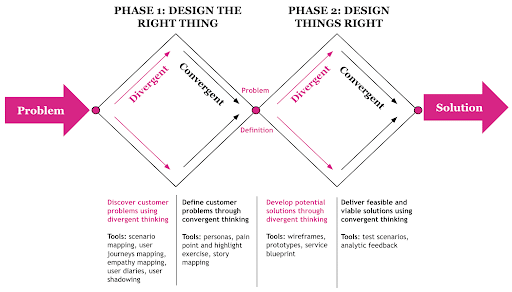Many organisations have deeply complex problems that are constantly changing in nature and require significant resources to resolve. Can customer-centric design thinking offer an effective solution?
Customer-centric design thinking
Customer-centric design thinking
Many organisations have deeply complex problems that are constantly changing in nature and require significant resources to resolve. Can customer-centric design thinking offer an effective solution?
Meet the author
Huge benefits can be unlocked by solving complex problems across an organisation’s Lead-to-Cash (L2C) lifecycle, but how does an organisation go about finding the right approach that has customers at the heart of changes made?
Knowledge across multiple disciplines is required when redesigning an organisation’s customer experience since it cuts across almost all functions of your organisation from marketing to service and even recruitment.
One way to broaden a person’s problem-solving skills would be to enrol in a multi-disciplinary course such as a professional programme at the London Interdisciplinary School.
However, many organisations do not have the time or money to send their people to University to learn how to solve the most complex problems.
There is a simpler, tried and tested solution: customer-centric design thinking.
What is the focus of customer-centric design thinking?
The focus of customer-centric design thinking is understanding the human aspects of the issue and taking a collaborative, trial and test-based approach to solution development.
This enables you to gain a real understanding of your customer, the challenges they face and the needs they have whilst testing underlying assumptions. The result is innovative ways to help your customer and/or end-user by addressing the root cause of the problem they are facing.
But, where to start? One method that is still advocated by the British Design Council is the ‘Double Diamond’. If this method is adopted with an agile mindset, it can be just as effective as deep research.
A study in the mid-‘00’s’, by the British Design Council, analysed methods used by the innovative companies of the time such as Microsoft and Yahoo and found they had similar thought processes based on a combination of divergent and convergent thinking:
- Divergent thinking — think broadly, keep an open mind, consider anything and everything. The focus is to solve the right problem.
- Convergent thinking — think narrowly, bring back focus and identify one or two key problems and solutions. The focus is to solve the problem right.
These concepts form the ‘Double Diamond’, a framework for identifying, structuring and delivering change:
Customer-centric design thinking using agile methods
The next step is to take your customer-centric design thinking and apply agile principles to test early, reflect and revisit as you learn more – rather than treating it as a linear process.
This helps you adapt to your evolving customer needs when necessary to deliver sustainable, long-lasting change.
Taking this approach to ensure collaboration, prioritisation and reflection had great results when we worked with one of our clients to improve customer relationships.
We combined agile, customer-centric and double diamond frameworks in central government. As part of a national response in a fast-paced and complex environment, we started by exploring the problem space using divergent thinking.
This included quantitative and qualitative analysis to explore the problem space, being led by users while being solution agnostic.
Once we understood the context and ecosystem of the problem, we had to apply convergent thinking to focus on what problem to solve. We prioritised the options through a customer-centric lens to ensure we solved the right problem.
Once agreed, we had our problem defined in detail and had confidence that among all problems identified, ours was the most important and right one to solve.
With the problem defined, we applied divergent thinking in the solution space to explore the various different solutions that could solve the prioritised problem. This included comparative analysis, iterating prototypes with users and blue-sky technical exploration.
Finally, we applied convergent thinking to choose the right solution based on customer desirability, technical feasibility and business viability.
By focusing on the problem first and alternating between divergent and convergent thinking, we were able to maximise the impact of our solution and deliver value earlier through ongoing iterations.
So what do we mean by collaboration, prioritisation and reflection?
Collaboration
Ah, the buzzword of the decade! We all claim to do it but what does good collaboration really look like?
In the case of the Double Diamond approach, it means facilitating internal and external interactions between customers and individuals across the entire organisation, throughout the thinking process.
This enables us to build solutions that are desirable, feasible, and viable.
Often designers talk to groups separately, but we advocate putting representatives in the same room. Having a half-day wireframing workshop on a small aspect of a problem with customers, technical teams and business SMEs will reap value much quicker than weeks of interviews.
It provides an opportunity to challenge assumptions, hear each other’s points of view and come up with innovative solutions as a team.
Prioritisation
Commonly, organisations consider this to be a case of what is in scope and what is out.
In customer-centric design thinking, this means focusing on what is most important to the customers or end-users and building out from there. Prioritise only the most critical scenarios and user journeys first and design the experience for these needs.
This thinking will form a backlog of enhancements to address the identified, critical scenarios, which can be constantly re-prioritised and resequenced based on what is most important to the customer and end-user.
Reflection
Often the Double Diamond can be approached as a linear model where you move from one phase to the next.
This aligns with a waterfall way of thinking, offering solutions that are unresponsive to volatile problems. To battle this mindset, there should be a continuous reflection on the problems and the solutions that are being developed.
By testing early, analysing outcomes and data, and collaboratively discussing how things are being done, you can ask yourself: are we still solving the right problem? Are we still solving the problem right?
Agile customer-centric design thinking can be the tool for you
By using the Double Diamond alongside agile principles throughout the transformation process, you continually recalibrate whilst ensuring your organisation has the full picture as well as the granular detail.
This approach to customer-centric design thinking can be a successful tool for solving complex organisational challenges and delivering a consistent customer experience.


